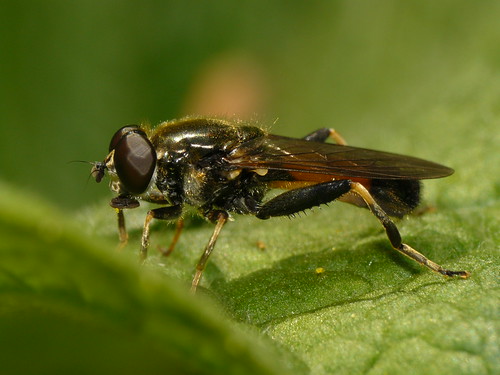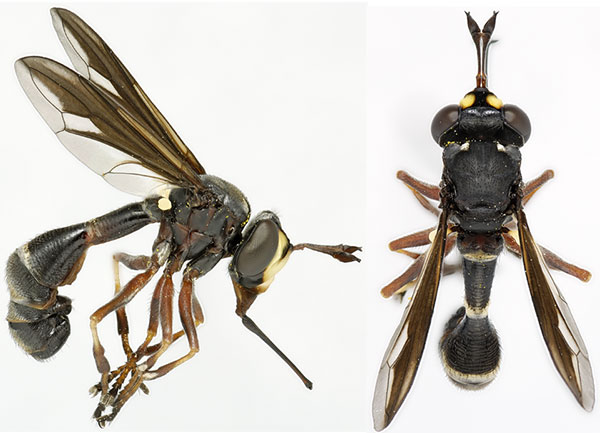Thread subject: Diptera.info :: Diptera Mimicry
Posted by Tony T on 18-09-2007 19:39
#1
A new thread to bring together those flies that mimic other species of insects.
This specimen gave me this idea, I would have bet it was an Hymenopteran
See:
Loxocera hoffmannseggi (
Psilidae)
It looks like it is mimicing an Ichneumonid.
Edited by Tony T on 22-09-2007 20:49
Posted by Tony T on 18-09-2007 22:16
#2
See:
Bumblebee mimic
Portschinskia loewi (
Oestridae: Hypodermatidae).
Edited by Tony T on 22-09-2007 20:46
Posted by Tony T on 19-09-2007 12:47
#3
See:
Bumblebee mimic
Merodon equestris,
Syrphidae, note the way wings held across abdomen, typical of bumblebees.
Edited by Tony T on 22-09-2007 20:46
Posted by Tony T on 19-09-2007 20:13
#4
Several
Syrphidae e.g.,
Temnostoma spp. such as
T. bombylans and
T. vespiforme mimic wasps, the latter species mimics
Vespula and
Dolichovespula spp.
See:
HERE
Edited by Tony T on 22-09-2007 20:45
Posted by jorgemotalmeida on 20-09-2007 01:54
#6
See:
Vespa crabro mimic
Milesia crabroniformis (Syrphidae) mimics
Vespa crabro (Vespidae).
Edited by jorgemotalmeida on 20-09-2007 02:03
Posted by Tony T on 20-09-2007 19:24
#7
This is a North American
Physocephala sp. (
Conopidae) that closely resembles a Potter Wasp (Hymenoptera: Vespidae: Eumeninae). In fact, when I first saw this fly on a flower I thought it was a Potter wasp.
Length: 10.5mm excluding antennae. 19 September 2007, New Brunswick, Canada.
Edited by Tony T on 22-09-2007 20:42
Posted by Tony T on 22-09-2007 17:08
#8
Tabanidae,
Hybomitra zonalis, female. 9 July 2005, NB, Canada. Length: range 14-18mm.
Black and yellow banding is quite common in many insects and is thought to be seen as a warning pattern to vertebrate predators. Black & Yellow banding, of course, is the basic colour pattern of stinging wasps which presumably form the model for this and the other wasp mimics.
Posted by Tony T on 22-09-2007 20:32
#9
Solitary Bee mimic:
Stratiomyidae >
Stratiomys longicornis
See:
HERE
Edited by Tony T on 22-09-2007 20:43
Posted by Alvesgaspar on 22-09-2007 23:28
#10
Wasp like syrphidic: Ceriana vespiformis
Please see here:
http://commons.wi...2007-2.jpg
Joaquim Gaspar
Lisboa
Posted by Alvesgaspar on 22-09-2007 23:49
#11
... and, of course, the "Drone-fly" (Eristalis tenax), whose model is the honey bee drone. In this photo the similarity is amazing:
http://commons.wi...007-3a.jpg
Joaquim Gaspar
Lisboa
Edited by Alvesgaspar on 23-09-2007 20:08
Posted by jorgemotalmeida on 22-09-2007 23:55
#12
C. vespiformis is very similar to Conops flavipes. But here it is convergent evolution, I think.
Both mimic wasps.
Posted by jorgemotalmeida on 23-09-2007 01:40
#13
Sepsidae flies have an appearance similar to some ants.
But I think this is another case of convergent evolution. Am I right? Anybody contests this assumption? Thank you.
Posted by crex on 23-09-2007 09:54
#14
If I remember correctly some Tephritidae mimics Salticidae spiders!?
Posted by Tony T on 23-09-2007 15:59
#15
jorgemotalmeida wrote:
Sepsidae flies have an appearance similar to some ants.
But I think this is another case of convergent evolution. Am I right? Anybody contests this assumption? Thank you.
Anything that runs around on the ground or on leaves and looks like an aggressive venemous predator has my vote for a mimic.
See:
Sepsidae > Australosepsis cf. niveipennis :
HERE
Edited by Tony T on 23-09-2007 16:00
Posted by Tony T on 23-09-2007 17:50
#16
crex wrote:
If I remember correctly some Tephritidae mimics Salticidae spiders!?
Need a photo of a
Rhagoletis from behind:D
According to Marshall "the wing-banding pattern....seen from behind.. makes the fly look remarkedly like a jumping spider (the bands look like spider legs)"
Who wants to tangle with a jumping spider?
Edit: Further reading indicates that the mimicry is to fool jumping spiders as these spiders are the major predators. "Greene et al. (1987) and Whitman et al. (1988) showed that
Z. vittigera mimics jumping spiders and is significantly protected from these common predators on its host plant. During the fly's wing flicking displays, its wing pattern resembles the legs and the abdominal spots the eyes of a spider in its own territorial display."
See:
Reference here
Edited by Tony T on 24-09-2007 13:54
Posted by Tony T on 24-09-2007 01:41
#17
Several Asilids in the genus
Laphria are mimics of bumlebees, e.g.,
Asilidae > Laphria affinis (male)
SEE:
HERE
Posted by jorgemotalmeida on 24-09-2007 17:01
#19
See:
Salticidae jumping spider mimic
Ceratitis capitata (Tephritidae) mimics
Salticidae jumping spiders.
Edited by jorgemotalmeida on 24-09-2007 17:05
Posted by Tony T on 24-09-2007 21:45
#20
I think we can put this in the same league as the "Alligator Bug" (Homoptera:
Fulgora laternaria), the head of which does look like an alligator and would be great mimicry apart from the discrepancy of habitat and size between the model and mimic:o.
Posted by Tony T on 25-09-2007 13:45
#21
A classic Bumblebee mimic by the syrphid: Syrphidae >
Arctophila bombiformis (female)
SEE:
HERE
Posted by Alvesgaspar on 02-10-2007 15:10
#23
Sepsidae flies mimic winged ants quite well, like this one (a Australosepsis sp.?)
Joaquim Gaspar
Posted by Tony Irwin on 02-10-2007 20:25
#24
Tony T wrote:
I think we can put this in the same league as the "Alligator Bug" (Homoptera:
Fulgora laternaria), the head of which does look like an alligator and would be great mimicry apart from the discrepancy of habitat and size between the model and mimic:o.
Perhaps we should look at this again - particularly at the newly-posted gallery image of
Rhagoletis completa (see
http://www.dipter...to_id=2344).
While I was scanning recent posts, I saw the thumbnail image of this picture out of the corner of my eye, and wondered why someone had posted an image of a
scorpion (rather than a crayfish)- perhaps a potential predator might make the same mistake, and leave it alone? :)
Edited by Tony Irwin on 02-10-2007 20:28
Posted by jorgemotalmeida on 02-10-2007 23:12
#25
Tony T wrote:
crex wrote:
If I remember correctly some Tephritidae mimics Salticidae spiders!?
Need a photo of a
Rhagoletis from behind:D
According to Marshall "the wing-banding pattern....seen from behind.. makes the fly look remarkedly like a jumping spider (the bands look like spider legs)"
Who wants to tangle with a jumping spider?
Edit: Further reading indicates that the mimicry is to fool jumping spiders as these spiders are the major predators. "Greene et al. (1987) and Whitman et al. (1988) showed that
Z. vittigera mimics jumping spiders and is significantly protected from these common predators on its host plant. During the fly's wing flicking displays, its wing pattern resembles the legs and the abdominal spots the eyes of a spider in its own territorial display."
See:
Reference here
Tony, really this is quite distinctive. Even in dorsal view (see the back of the fly) it seems a salticid spider!! (very convincing) . See here >>
http://www.dipter...to_id=2344
Posted by kyl on 03-02-2008 21:09
#26
When i saw the picture of Rhagoletis from afar, (or without glasses :P)it looks like a spider backwards.. The bold bands on the wings as the spider forelegs and the fly's head as the spider's abdomen....
What about Celyphidae? Does looking like a beetle confer any protection? And I believe their flight isnt that great either?as mentioned in the Threads.
Posted by LakeSide on 24-04-2008 15:07
#27
Eristalis intricaria as bumblebee mimic:

and Xylota segnis does a good sawfly impression IMO

Posted by AaronS on 28-11-2018 06:14
#28
The nice pair of lateral + dorsal photos that Tony T posted earlier in this thread (see below) show a very dark specimen of
Physocephala furcillata...which is pretty much the only conopine that seems to make it as far northeast as New Brunswick in North America.
Tony T wrote:
This is a North American
Physocephala sp. (
Conopidae) that closely resembles a Potter Wasp (Hymenoptera: Vespidae: Eumeninae).

In fact, when I first saw this fly on a flower I thought it was a Potter wasp.
Length: 10.5mm excluding antennae. 19 September 2007, New Brunswick, Canada.




